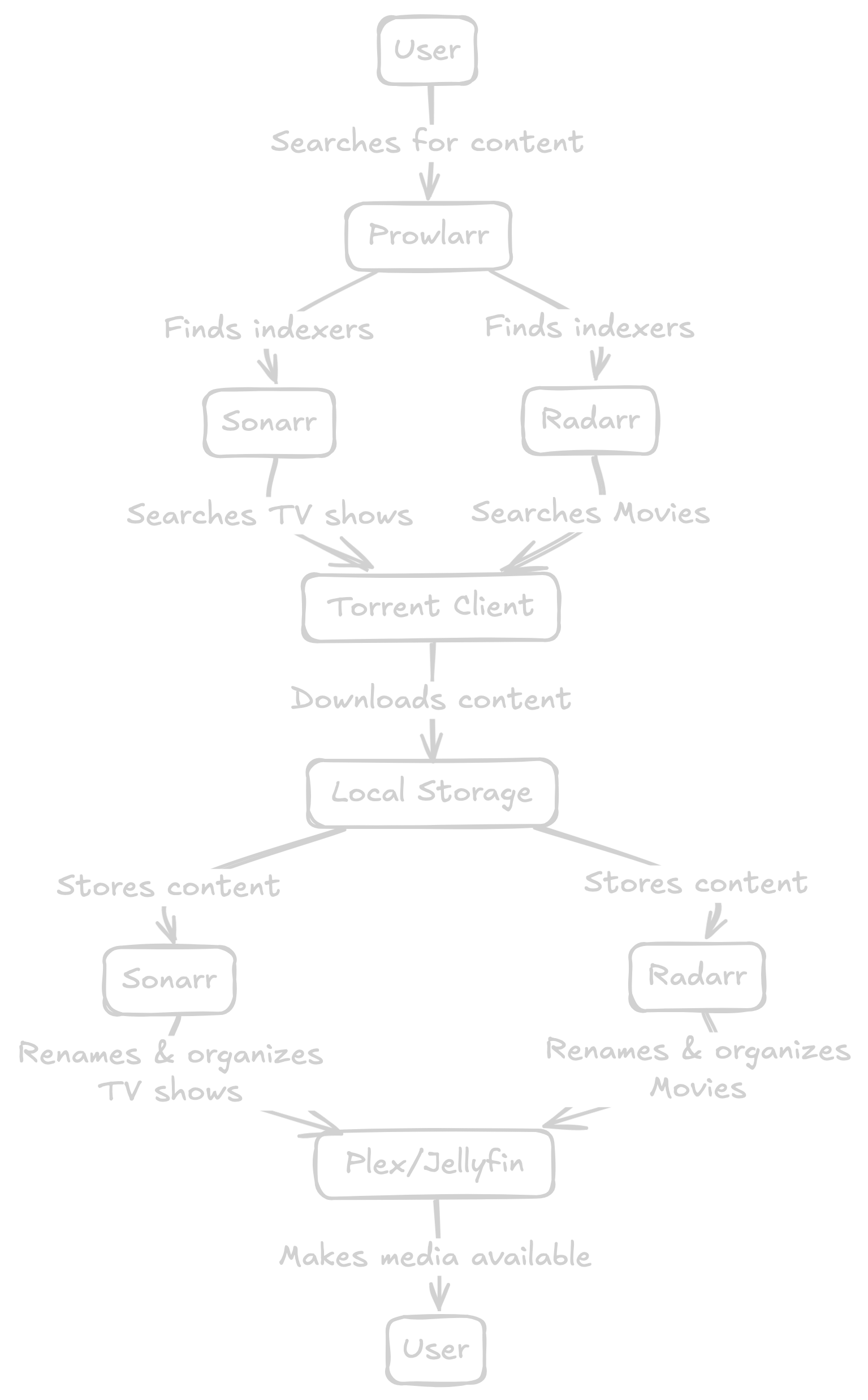TL;DR: Don’t do anything illegal. Jump to the Totally Legal Use Cases section for all the cool legal use-cases.
Intro
In Part 1, I walked through building my Unraid server — migrating from a mini-PC and laying the hardware foundation for a reliable homelab. The goal: build a flexible, automated media server that runs cleanly and requires minimal manual intervention.
In this post, I’ll cover how I automated everything using Docker, Trash Guides, and a suite of containers — including Plex, Jellyfin, Sonarr, Radarr, and more — all working together to provide a seamless media experience.
Why Media Automation?
Manual downloading, sorting, and renaming gets old fast.
By combining Torrent clients, indexer managers, and media managers into a single pipeline, I’ve built a system where content shows up automatically — properly named, sorted, and ready to watch on Plex or Jellyfin.
Trash Guides provides the logic and tuning needed to make this setup opinionated, fast, and accurate, prioritizing good-quality releases and reducing duplicates or mismatches.
Docker Stack Overview
All of this runs in Docker on Unraid, using community templates and pinned images for stability. Here’s what powers my media automation:
🧱 Core Automation Stack (Binhex)
binhex-qbittorrentvpn
A torrent client with built-in VPN support — all downloads route through my ProtonVPN for safety and privacy.binhex-sonarr
Watches for new episodes of TV shows, sends them to the torrent client, and processes downloads automatically.binhex-radarr
Same as Sonarr, but for movies — with support for quality profiles like 1080p WebDL, Remux, or 4K.binhex-prowlarr
Centralizes and manages all indexers for Sonarr and Radarr.binhex-flaresolverr
Required for solving Cloudflare challenges, especially on public indexers.
Library Frontends & Stats
binhex-plexpass
My go-to for streaming — I do like FOSS but especially on my Apple TV at home, Plex has imo the best user experience.jellyfin
Used alongside Plex for a FOSS, local-first experience. Not a fan for running on Apple TV but super useful for sharing my media with friends outside my network via Tailscale.tautulli
Tracks Plex usage: who’s watching, how often, and from where. I mostly use it to monitor playback quality if for some god forsaken reason my streams ever start stuttering.jellystat
Tautulli, but for Jellyfin.
Request Management
jellyseerr
My preferred front-end for managing media requests. Connected to Plex/Jellyfin and Radarr/Sonarr, it allows my users to request shows or movies, and everything else happens automatically behind the scenes.

Folder Structure & Unraid Shares
Here’s how I keep my data organized inside Unraid. All Docker containers map to a central share called data, with subfolders for torrents and media.
/mnt/user/data/
├── torrents/
├── media/
│ ├── movies/
│ ├── tv/
│ └── etc/
torrents/is whereqBittorrentVPNdownloads files.media/is whereSonarrandRadarrmove and rename content post-download.PlexandJellyfinpoint here.- Mount paths are consistent across containers (e.g.,
/data/torrents,/data/media) to avoid path mismatches or hardcoding.
Pro tip: Keeping everything under a single
datashare makes backups and parity protection easier on Unraid.
Trash Guides: Why I Follow Them
Trash Guides is the foundation of this setup. Their documentation walks through best practices for:
- Custom Formats – Prefer proper scene releases, HDR versions, or group-specific uploads.
- Quality Definitions – Define what qualifies as a “good” 1080p or 4K file.
- Release Profiles – Filter out re-encodes or low-bitrate junk.
- Indexer setup – Recommendations for tracker hygiene and
FlareSolverrintegration.
How It All Flows
- Jellyseerr (or me) requests a movie/show.
- Sonarr/Radarr queue the release via Prowlarr indexers.
- qBittorrentVPN downloads it securely.
- Sonarr/Radarr process, rename, and move it to
/data/mediasubfolder. - Plex and Jellyfin scan the folders and update libraries.
- Tautulli and Jellystat track usage and provide insights.
All I do is add a show to Jellyseerr. Everything else is automated.
Totally Legal Use Cases
Now, before you get any ideas — this whole setup is, of course, intended purely for legal and legitimate purposes. Here are some 100% definitely-common use cases for an automated torrent-fed media server:
Archiving your personal DVD and Blu-ray collection
Because…why not?Downloading open-source Linux ISOs
You never know when you’ll need 27 different versions of Ubuntu, organized by quality, release group, and codec.Curating public domain noir films from 1946
Trash-guides-poweredSonarr+Prowlarrcombo to auto-grab D.O.A. and The Hitch-Hiker? Yes please.Creative Commons indie documentaries
Okay maybe not that one.
This guide obviously does not condone using any of this technology for acquiring content you don’t have the rights to. That would be wrong. And illegal. And not I wanted to teach you about.
